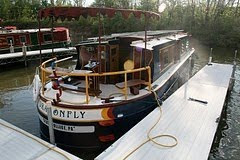 |
| What next? Do Not Offer Manatees a Ride on Your Kneeboard? |
"Do Not Pet Manatees." Makes sense.
"Do Not Feed Manatees." Ditto.
"Do Not Give Water to Manatees." Huh? This baffled me. I pictured some touron (cross between tourist and moron) lobbing plastic water bottles overboard. Or extending a Big Gulp cup to a manatee who was tailwalking, porpoiselike, near the boat.
Nawww. Who would do THAT?
Cap enlightened me. Manatees live both in freshwater rivers and in salty estuaries. It's not clear they absolutely require fresh water to drink, but they do like it--they're attracted to springs and drainage pipes. Apparently folks have learned you can attract a manatee to your dock or to your boat by hooking up a garden hose and squirting water overboard. But like the sign says, Don't.
I went for a walk at sunset and spotted some white birds stalking through the park that forms the marina seawall, past the picnic tables and around the trash barrels. They were awfully large, awfully chubby, and awfully bald for great egrets. Hah! Wood storks!
 |
| Poster child for the "bald is beautiful" movement |
Here's some specifics in the stork story: Wood storks hunt by touch, swishing their long beaks back and forth through the water, then snapping them shut--fast as a beartrap--when they feel something edible.
Storks eat fish, tadpoles, crawfish . . . any little thing you might find in marshy places. They have to collect a lot of chow to feed their nestlings. So stork nesting season is timed to coincide with the point when (if natural cycles are functioning naturally) lakes and marshes are drying out and water levels are low. Think of boiling down broth to make stock (without the boiling part!) With low water levels, prey is concentrated in a smaller area, easier to catch.
As development accelerated in Florida in the mid- 20th century, that messed with natural water regimes. Stork populations dropped from about 20,000 pairs in the 1930s to about 5,000 pairs in the 1970s.
Since then, stork numbers have rebounded at bit--partly because some stretches of habitat have been protected, partly because storks have taken to living in new places north of their historic range. And some storks have changed their habits. Once associated with wild places exclusively, storks can now be spotted along city canals.
The Florida Home Builders Association filed a petition in 2009 to reclassify the species as "threatened" rather than "endangered," charging that the current classification infringes on peoples' right to use their land as they see fit. Another part of the argument is that having endangered species on a chunk of land blocks projects that can bring jobs.
This past fall, after the association threatened to sue, the U.S. Fish and Wildlife Service took public comments on the issue--part of a year-long study to see if the reclassification is warranted.
It's heartening to learn that storks are flexible enough to adapt to new places and to living in closer contact with humans. Not all species can do this. But many organisms are more adaptable than you might think.
 |
| Across the Intracoastal from Titusville: The building where NASA assembles the Space Shuttle. 10,000 NASA employees are about to be unemployed. Hmm, does the region need MORE housing? |
On the other hand, endangered species should not be a convenient front man when environmentalists to object to development. It's easy to say "we should project an endangered species"; it's harder to explain exactly why we should.
And then on the other hand (I think that's three hands, but so what) when business interests say, "an ugly awkward bird with no apparent value should not take precedence over people who need jobs and homes," that's an argument with a fallacy at its base.
Both Cocoa (where we visited earlier in the week), and Titusville have expensive and elaborately engineered waterfront parks, recently built, designed to deal with flooding. Flooding caused by the asphalt-ization of the land.
Hmm. Storks need wetlands. Wetlands sop up runoff.
I noticed, in passing that, like the marina with its "Do Not Feed the Manatees" signs, these water-control projects have educational billboards.
Clearly, neither one is sufficient.
P.S. More random fun photos HERE





No comments:
Post a Comment